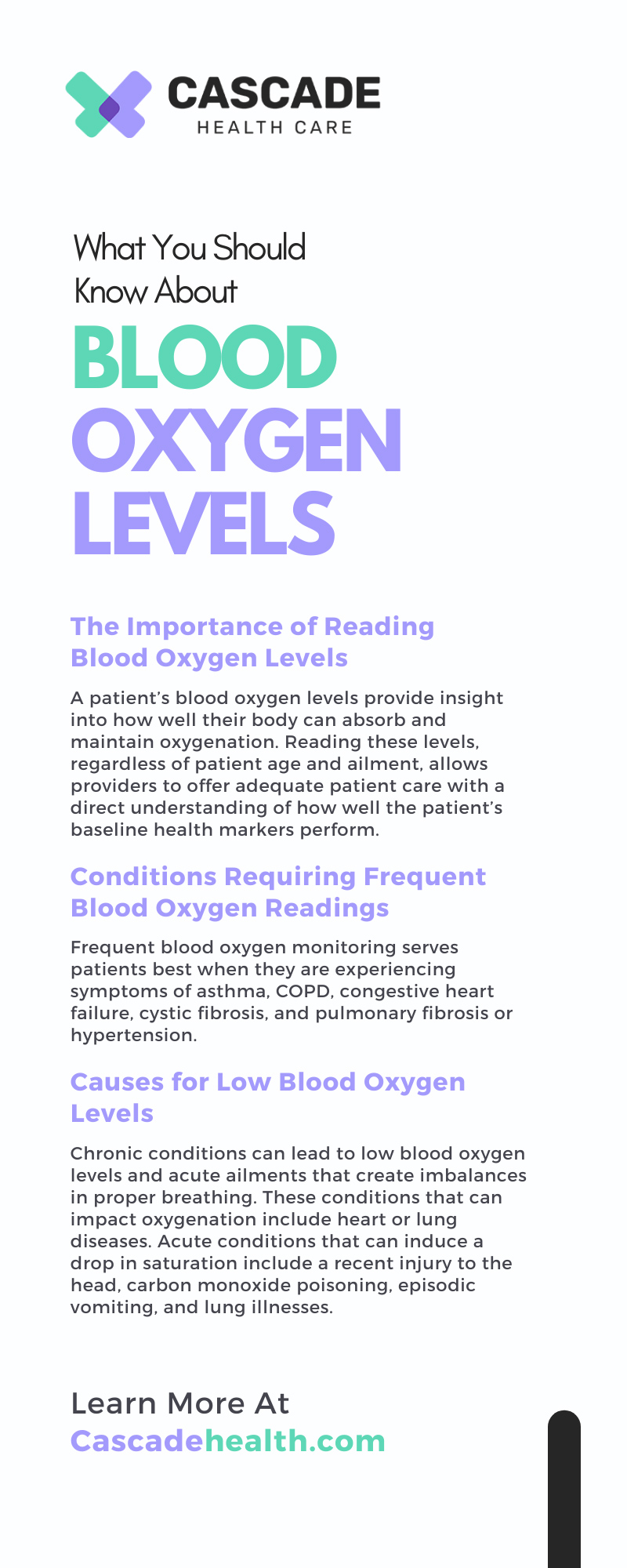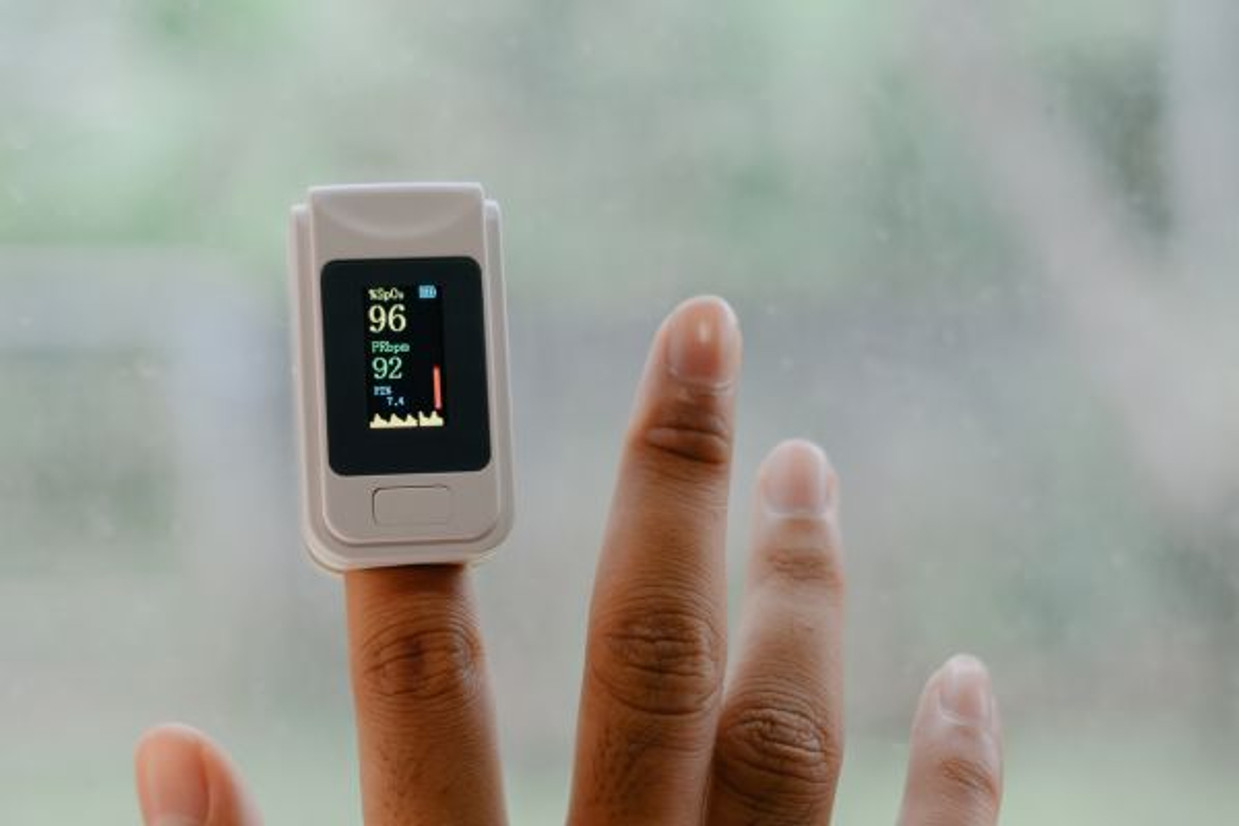What You Should Know About Blood Oxygen Levels
Measuring and monitoring various baseline health markers are some of the most important things medical professionals do with patients. They are commonly referred to as vital signs and indicate the severity and level of care a patient may need at any given time. The pulse oximeter reading is part of this list of baseline measurements, which assesses blood oxygen saturation. In this article, we explore what you should know about blood oxygen levels and why proper measuring and monitoring are important for patients.
The Importance of Reading Blood Oxygen Levels
A patient’s blood oxygen levels provide insight into how well their body can absorb and maintain oxygenation. The inhaled oxygen goes through the lungs and into the bloodstream, creating blood oxygen saturation. Reading these levels, regardless of patient age and ailment, allows providers to offer adequate patient care with a direct understanding of how well the patient’s baseline health markers perform.
Everybody requires an appropriate level of oxygenation for proper health. Once the oxygen reaches the bloodstream, it can travel throughout the body and enter cells to establish proper energy efficiency, which aids thinking, digestion, movement, and many more processes. Cell-based oxygen creates carbon dioxide and is the exhaling breathe through the nose or mouth, resulting in the full breathing cycles necessary to sustain life.
Another vital thing you should know about blood oxygen levels is if they fluctuate too high or too low, a patient may experience severe complications. Understanding how to perform a test and read the results is a vital part of optimized and ethical patient care.
Conditions Requiring Frequent Blood Oxygen Readings
Many patients will encounter a pulse oximeter reading device regardless of their health and current condition. As mentioned previously, the reading is a baseline health marker that professionals use to understand their patient’s breathing.
A variety of conditions require frequent blood oxygen readings because they put patients at risk of circulatory impairments or lung capacity issues. Additionally, patients with chronic heart conditions may be required by professionals to have regular blood oxygen tests to monitor their baseline health.
Frequent blood oxygen monitoring serves patients best when they are experiencing symptoms of asthma, COPD, congestive heart failure, cystic fibrosis, and pulmonary fibrosis or hypertension. These conditions affect lung capacity and cardiac response, and understanding the blood oxygen levels in these circumstances is vital.
Pulse Oximetry
A pulse oximeter is one of the most common devices used to test blood oxygen. A clip-like device attaches to a patient’s finger, toe, or ear lobe and reads their pulse, relaying the oxygen saturation.
Pulse oximeters are externally applied devices that are harmless and painless to patients and offer rapid results to health care providers. Patients requiring frequent readings may purchase a device for in-home use per their overseeing provider’s recommendations.
Oxygenation Blood Draw
Depending on a patient’s ailment, presentation, and reason for care, a provider may choose an oxygenation blood draw which will provide insight into more than blood oxygen levels. These tests are known as ABG tests, or arterial blood gas tests, and measure oxygen saturation, carbon dioxide levels, and the pH balance of the blood.
These comprehensive tests are vital for patients experiencing chronic conditions. When the blood’s acidity is too high or too low, this can cause serious harm to a patient’s health and should be treated immediately.
Causes for Low Blood Oxygen Levels
Chronic conditions can lead to low blood oxygen levels and acute ailments that create imbalances in proper breathing. These conditions that can impact oxygenation include heart or lung diseases. Acute conditions that can induce a drop in saturation include a recent injury to the head, carbon monoxide poisoning, episodic vomiting, and lung illnesses.
Providers will examine patients thoroughly and begin most exams with blood oxygen readings to gain baseline health information about the patient. From there, treatments and prevention may help a patient sustain proper blood oxygen levels.
Normal blood oxygen levels range between 95 and 100 percent. A patient may experience hypoxemia if they are above or below this range. Providers must take immediate action when results are below 88 percent, as this is a cause for concern.
Signs and Symptoms To Check
A patient may present a variety of signs and symptoms alerting you that their blood oxygen levels are too low or potentially too high. The severity of their symptomatic presentation will vary based on other health markers and chronic conditions.
Common signs and symptoms of someone experiencing low blood oxygen levels or hypoxemia include harsh coughing, shortness of breath, mental confusion, increased heartbeat, blue-colored lips or nails, and wheezing.
Treatment for Hypoxemia
The treatment for hypoxemia depends greatly on whether chronic or acute conditions are present at the time of a low blood oxygen test result. For some people, supplemental oxygen can resolve the situation. However, the severity of the existing conditions will change the course of action a provider takes.
Respiratory distress from an acute ailment like an injury or illness may require a ventilator. Additional respiratory therapies and medications may be necessary if the hypoxemia doesn’t resolve with breathing treatment. Common long-term treatments include diuretics to remove fluid buildup in the lungs, inhalers or steroids, continued supplemental oxygen therapies, and CPAP machines to resolve sleep apnea disorders.
Hypoxemia Prevention Measures
Because hypoxemia can arise from an existing chronic condition, one of the best preventions for issues is to manage chronic health conditions thoroughly. Proper health management is the best way to understand baseline markers and maintain the effects of acute conditions. Alternatively, providers may suggest that patients quit smoking to avoid increased lung illnesses, avoid areas with excessive air pollution, and proactively prevent infections that may lead to pneumonia. Any condition affecting the lungs and heart can result in chronic and acute hypoxemia.
Cascade Health Care proudly offers a range of blood oxygen measuring devices to support medical professionals in all settings. We have a comprehensive selection of adult and pediatric pulse oximeters, ensuring all professionals can access quality devices and tools. Offering pertinent and ethical patient care begins with an inventory of adequate tools. Partner with us to learn more!

Recent Posts
-
Must-Have Tools and Instruments for Obstetric Care
Obstetric care demands a unique blend of clinical expertise, intuitive patient management, and preci
-
Positions for Out-of-Bed Laboring During a Home Birth
For midwives, doulas, and other healthcare professionals who attend home births, facilitating a safe



